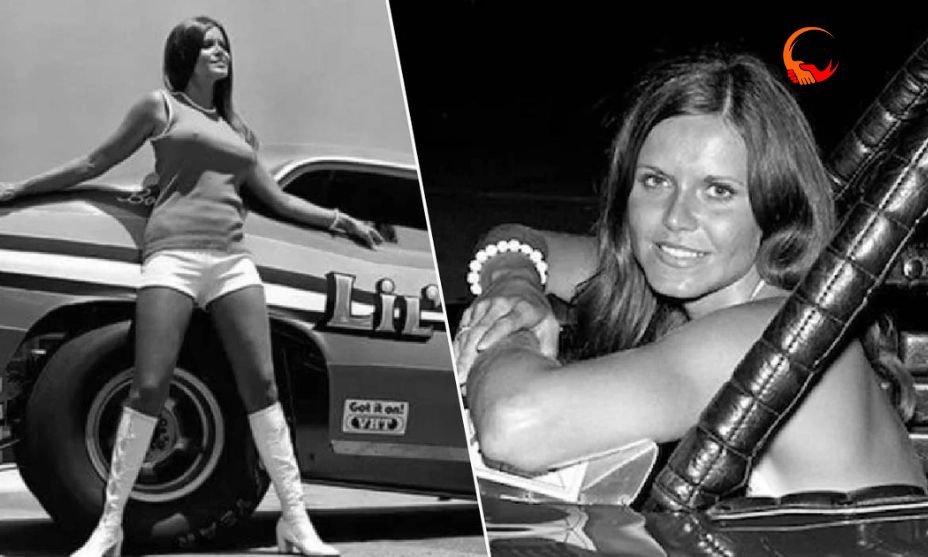Table of Contents
Introduction to Barbara Roufs
Barbara Roufs was a standout figure in the drag racing world of the 1970s, celebrated for her vibrant personality, glamorous style, and role as a “trophy girl” at popular drag racing events. Unlike typical racers or crew members, Barbara’s presence brought a unique charm to the track, embodying a blend of fashion, excitement, and femininity that added a new dimension to drag racing. The “trophy girl” role wasn’t just about presenting awards; it was about adding an element of entertainment and attraction, making races more memorable for fans.
With her striking long hair, signature 1970s attire, and outgoing personality, Barbara became an unforgettable figure in a male-dominated sport. Her influence extended beyond appearances, as she contributed to making the drag racing scene more welcoming and accessible to a broader audience, especially women. Her enthusiasm for the sport and her interactions with racers and fans alike brought her widespread admiration.
Barbara’s iconic status was further solidified when she was crowned the queen of the Professional Dragster Association (PDA) in 1973. This recognition wasn’t only for her looks but also for the way she engaged the crowd, creating a lively and inclusive atmosphere at every event. Even today, enthusiasts of drag racing look back at Barbara Roufs as a pioneer who made an undeniable mark on the sport’s culture.
Early Life and Background
Barbara Roufs was born in 1944 in California, a state known for its vibrant car culture and the emerging drag racing scene of the 1950s and 60s. Growing up in the Golden State, Barbara was surrounded by the booming automotive industry, which undoubtedly influenced her interest in cars and racing. This was a time when car clubs and racetracks were popular, and young people were drawn to the thrill of speed and competition. Barbara’s surroundings played a crucial role in shaping her future, setting the stage for her involvement in drag racing, a sport that would eventually bring her fame.
During her youth, Barbara witnessed the early days of drag racing, which was rapidly gaining popularity across the United States. While racing was predominantly male-dominated, the allure of speed and excitement also attracted women, both as fans and, occasionally, as participants. Barbara grew up in an era when car culture and motorsports were thriving, with events regularly held at venues like the Orange County International Raceway. Her exposure to this exciting world from a young age likely sparked her passion for the scene, even if she didn’t initially plan to become a part of it.
Barbara’s background wasn’t strictly limited to drag racing or cars; she was also influenced by the cultural movements of the 1960s and 70s. The era was marked by changes in fashion, music, and lifestyle, and Barbara embodied the free spirit of the time. Known for her long, flowing hair and classic go-go boots, she captured the essence of 1970s fashion, blending her personal style with the bold, adventurous spirit of drag racing. This made her a unique personality who could seamlessly fit into the exciting atmosphere of racing events.
While details about her family life remain sparse, it’s known that Barbara had a natural charisma that made her a favorite among her peers. Her easygoing nature and friendly disposition allowed her to connect with a wide range of people, from racers to fans. Even before becoming a public figure, Barbara’s personality set her apart, making her the kind of person people enjoyed being around. This charm would later make her a fan favorite at drag racing events, where she brought a touch of glamour and excitement.
Barbara’s journey into the drag racing world wasn’t a direct path. Initially, she wasn’t involved in the racing scene, but her unique style and outgoing personality eventually led her to the role of a trophy girl. The title “trophy girl” may sound simple, but in the context of 1970s drag racing, it was a role of significance. Barbara’s entry into this world marked the beginning of her iconic status, as she went on to become one of the most memorable figures in the sport.
Career Highlights in Drag Racing
Barbara Roufs made her debut in the drag racing world in the late 1960s, quickly becoming a celebrated figure. Her role as a trophy girl placed her at the center of major racing events, where she presented trophies to winners and engaged with fans. The title “trophy girl” was more than just a ceremonial role; Barbara brought her own flair to the position, often dressed in 1970s fashion, complete with her long hair, vibrant outfits, and iconic go-go boots. Her presence added excitement and glamour to each event, making her a memorable part of the racing experience for both fans and participants.
One of Barbara’s most notable career highlights came in 1973 when she was crowned the queen of the Professional Dragster Association (PDA). This title was a testament to her popularity and the impact she had on the sport. Being named PDA queen wasn’t merely about appearances; it was a recognition of her charisma, her dedication to the sport, and her ability to engage with the crowd. Fans and racers alike admired Barbara for her genuine love of the sport, and her PDA queen title solidified her status as a central figure in the drag racing community.
Barbara’s presence at racing events was significant not just for her personality but also for the way she helped bring more attention to the sport. Drag racing in the 1970s was still growing, and having someone like Barbara involved attracted more fans, especially young women, who saw her as a relatable and inspiring figure. Her involvement in events like the U.S. Professional Dragster Championship at the Orange County International Raceway helped make drag racing more accessible and appealing to a broader audience. Her role demonstrated that women could have a place in motorsports, even if they weren’t behind the wheel.
Throughout her career, Barbara became known for her friendly interactions with fans. She would often take time to chat with attendees, sign autographs, and pose for photos. This approachability made her incredibly popular, as fans felt a personal connection to her. Barbara’s enthusiasm for drag racing was clear in every interaction, and her genuine love for the sport resonated with fans. This dedication to connecting with people contributed to her lasting legacy, as she became a symbol of the golden age of drag racing.
Barbara’s career in drag racing wasn’t long, but her impact was profound. Even decades after her time as a trophy girl, her images and memories continue to capture the imagination of drag racing fans. Her career may have been brief, but Barbara’s unique contribution to the sport has left a lasting impression, making her one of the most iconic figures in drag racing history. Her blend of style, charm, and dedication to the sport set her apart, creating a legacy that endures to this day.
Personal Life and Legacy
Barbara Roufs’s personal life, though not extensively documented, was marked by her warmth and charisma. She was known for her friendly personality, making her a beloved figure not only on the drag racing circuit but also among her friends and family. Though her career in drag racing brought her fame, Barbara valued her relationships and took pride in being a kind and approachable person. This side of her added depth to her public persona, as fans appreciated her genuine nature both on and off the track.
In January 1991, Barbara Roufs passed away at the age of 47, a tragic loss for her family, friends, and fans. Her death, which was reported as a suicide, left a sense of mystery and sadness around her life. Though the reasons behind her decision remain unknown, the loss of such an iconic figure had a profound impact on those who knew her and on the drag racing community at large. Her untimely passing added a bittersweet note to her legacy, as fans remembered her for the joy and excitement she brought to the sport.
Despite her passing, Barbara Roufs’s legacy has continued to thrive. In recent years, a renewed interest in vintage drag racing photos brought Barbara back into the spotlight, with fans celebrating her iconic style and contribution to the sport. The images of Barbara at various racing events have become nostalgic reminders of a vibrant era in drag racing history. Her legacy lives on through these photographs, which capture the energy and spirit she brought to every event she attended.
Barbara’s influence on drag racing extends beyond her role as a trophy girl. She became a symbol of the 1970s drag racing scene, embodying the era’s style and excitement. For many fans, Barbara represented the golden age of drag racing, a time when the sport was gaining popularity and attracting new audiences. Her contributions helped pave the way for a more inclusive atmosphere in motorsports, showing that women could play a significant role in a male-dominated field.
Today, Barbara Roufs is remembered not just as a trophy girl but as an icon of her time. Her lasting influence on drag racing is a testament to the impact she had on the sport and on the fans who adored her. While her life was cut short, Barbara’s legacy endures, as she continues to inspire fans and drag racing enthusiasts who look back at her life with admiration and respect.
For More Visit : Businessdesert







